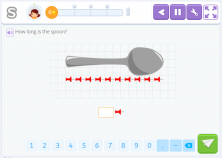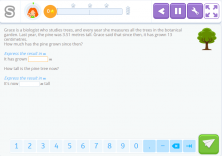In today’s post, we will be talking about the magnitude of length and its difference to distance, as well as how both concepts are integrated into knowledge at young ages.
Before anything, we should ask ourselves if we really know the meaning of these concepts: What is a magnitude? What is the magnitude length? What is distance?
Concepts of length, distance, and the difference between them
An object has various characteristics, attributes, and properties, some we can see and others we cannot but only those that are observable and given a numerical value are magnitudes. As a result, all of the attributes that cannot be given a numerical value are not magnitudes.
The magnitude of length is the amount of ‘complete’ space, the measurement between two points in a dimension or an object, typically the length.
So, what does the concept of distance refer to? Well, the distance is the ’empty’ space between two points, in other words, the space that exists between two objects.
Therefore the distance between the magnitude length and distance is as follows: length is used to measure part of an object and the distance is used to measure the space between objects (or points).
Acquisition of the concepts of length and distance
Length requires a simpler level of compression to understand and since its perception is less conflictive, you can begin working on these concepts with younger ages in school. Once the spatial skills and the distance between objects are developed, the construction of the concept of distance can be incorporated.
Spatial capacity with primary aged school children is very ambiguous while the concept of length develops little by little and will progress according to the experiences that the child has related to this topic. The handling of materials more familiar and close to the child will help this develop along the way.
For example, we can begin using erasers, pencil sharpeners, or clips to know the length of a pen or relatively small objects. Later we will be able to move on and measure larger lengths and compare the lengths of some objects. During this process, the concept of space will be expanded and we will be able to move on to measuring distances between objects within the school until we finally get to larger distances like those that exist between their houses and school.
“You cannot teach a man anything; you can only help him find it within himself.” – Galileo Galilei
The eagerness to discover, explore, and know from the time that we were children, and as human beings with the innate capacity to understand all that surrounds us, it is a great advantage when we are faced with challenges and new things. With the Smartick method, they work on new concepts and advance towards greater challenges simply.
In Smartick, students begin working with length from 4 years old with activities where they compare objects and measure them by using other smaller objects.

We then move onto units of measurement, their abbreviations, and conversions.
In order to finally arrive at the solution to a length problem and more complex measurements.

Would you like to see how your children or students gradually learn this concept?
You can register with Smartick and try it or free! Smartick is available for tablets and computers in both English and Spanish.
Learn More:
- Learn More about Measurements of Length
- Dimensions: Length, Width, and Height of an Object
- Learn to Solve Measuring Problems
- Practice Length Measurement Problems
- Measurements of Capacity with the Metric System







